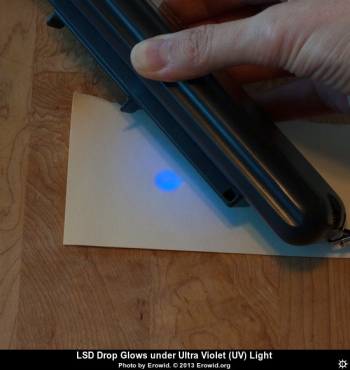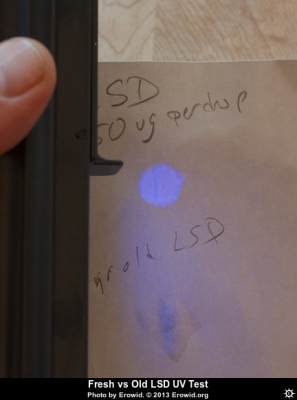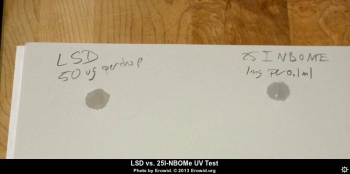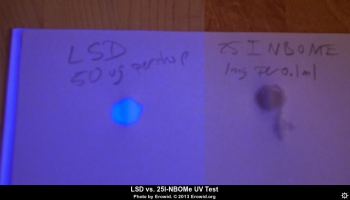LSD Glows under Ultraviolet (UV) Light
Sep 12, 2013
Citation: Erowid E, Erowid F. "LSD Glows under Ultraviolet (UV) Light". Erowid.org. Sep 12, 2013. Erowid.org/chemicals/lsd/lsd_testing2.shtml
LSD has been known to glow under ultraviolet or black light since at least the 1950s 1, but Erowid had never previously had access to confirmed LSD and an ultraviolet light. We recently photographed under black light fresh liquid LSD versus seven-year-old LSD, as well as liquid LSD versus 25I-NBOMe spots on paper. The primary light we used was a handheld Spectroline Model UV-5NF, but we also used two other battery-operated UV lights. All the UV light sources showed the same results, but the Spectroline UV-5NF photographed best. Even the LED UV micro lights caused the LSD to fluoresce clearly, so it is not necessary to use an expensive UV lamp to rule out LSD. If something sold as LSD does not fluoresce, it does not contain LSD. If it does fluoresce, it could be many things and LSD is one possibility.
The seven-year-old LSD was reported by the owner to be very weak. Neither the old LSD nor the 25I-NBOMe showed any visible reaction to UV light while the fresh LSD glowed brightly.
In order to test for LSD using a UV light, we first checked the papers themselves under the light to determine whether or not (and to what degree) a given untreated paper sample glowed. Some bright white and colored papers glowed brightly enough under UV light on their own, without any LSD present, that a glowing spot would have been hard to identify. After we verified a paper sample that did not glow at all by itself, a drop of the liquid LSD (in this case, LSD in alcohol solution) was applied to the paper.
The spot of LSD fluoresced (glowed) brightly under the UV light. We played with the UV lamp and the LSD in a variety of ways, on a number of different papers. The LSD fluoresced when dry or wet.
Note that LSD is destroyed by UV light in the presence of oxygen, including in water or non-anhydrous alcohol (anhydrous alcohol absorbs water very quickly out of the air and does not remain anhydrous very long in normal environments).2 Although a brief exposure to UV will not substantially weaken a single tab of acid, exposure to sunlight or long exposure to a UV lamp will destroy LSD molecules, converting the d-LSD to lumi-LSD.
The seven-year-old LSD had been lab confirmed at the time it was first purchased. The LSD from 2013 was confirmed to be LSD experientially by a group of people who had previously taken LSD on many occasions. Although no lab confirmation of the LSD was conducted, it tested positive for LSD using two different LSD field tests.
The seven-year-old LSD was reported by the owner to be very weak. Neither the old LSD nor the 25I-NBOMe showed any visible reaction to UV light while the fresh LSD glowed brightly.
In order to test for LSD using a UV light, we first checked the papers themselves under the light to determine whether or not (and to what degree) a given untreated paper sample glowed. Some bright white and colored papers glowed brightly enough under UV light on their own, without any LSD present, that a glowing spot would have been hard to identify. After we verified a paper sample that did not glow at all by itself, a drop of the liquid LSD (in this case, LSD in alcohol solution) was applied to the paper.
The spot of LSD fluoresced (glowed) brightly under the UV light. We played with the UV lamp and the LSD in a variety of ways, on a number of different papers. The LSD fluoresced when dry or wet.
Note that LSD is destroyed by UV light in the presence of oxygen, including in water or non-anhydrous alcohol (anhydrous alcohol absorbs water very quickly out of the air and does not remain anhydrous very long in normal environments).2 Although a brief exposure to UV will not substantially weaken a single tab of acid, exposure to sunlight or long exposure to a UV lamp will destroy LSD molecules, converting the d-LSD to lumi-LSD.
The seven-year-old LSD had been lab confirmed at the time it was first purchased. The LSD from 2013 was confirmed to be LSD experientially by a group of people who had previously taken LSD on many occasions. Although no lab confirmation of the LSD was conducted, it tested positive for LSD using two different LSD field tests.
References #
- Boyd ES. "The fluorometric determination of lysergic acid diethylamide and ergonovine". Arch Int Pharmacodyn Therap. 1958;115:43-51.
- Niwaguchi T, Inoue T. "Studies on quantitative in situ fluorometry of lysergic acid diethylamide (LSD) on thin-layer chromatograms" J. Chromatogr.. 1971;59:127-133.
- Shulgin A, Shulgin A. "#26. LSD-25" TIHKAL. 1997. Niwaguchi T, Inoue T. "Photodecomposition of Lysergic Acid Diethylamide (LSD)" Porc. Japan Acad. 1971;47(9):747.






